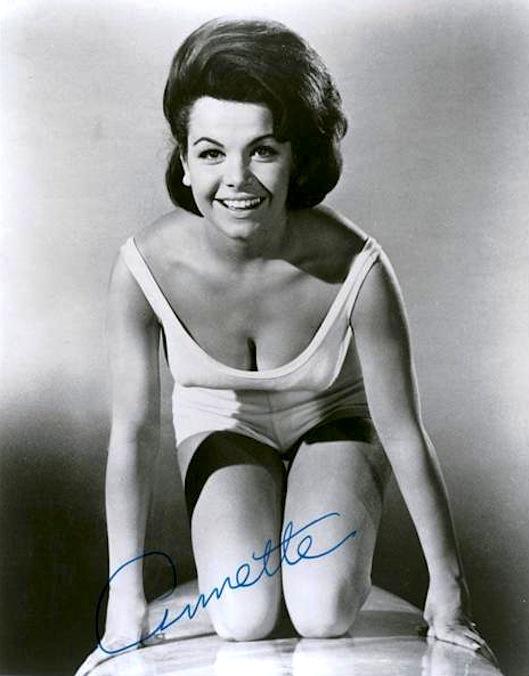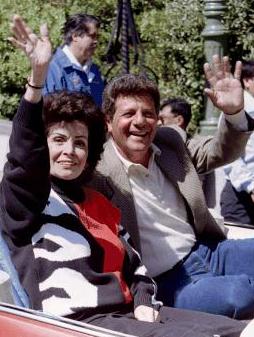Way ahead of everyone…The Enduring Girls of Summer: Annette (Pt. 1)
Annette: Trailblazer. Dig It.
By David McGee
Suggesting that the recording oeuvre of Annette Funicello merits reconsideration is likely a hard sell even to readers of this publication. But the raven-haired, dark-eyed teen beauty born Annette Joanne Funicello on October 22, 1942, in Utica, New York, who became known as “America’s Girl Next Door” and is forever associated with a simpler, more innocent America and a brace of simplistic beach party movies with her buddy Frankie Avalon, could legitimately lay claim to opening doors for a host of gifted teen girl singers in the ‘60s and laying the groundwork for a more sophisticated teen pop that ultimately produced Lesley Gore’s 1964 pre-feminist anthem “You Don’t Own Me” and Sandy Posey’s frank, conflicted (and perhaps subversive--she decries all the humiliations visited on the distaff sex, then concedes she’s happy to be under her husband’s thumb…but what was she really saying?) 1966 screed, “Born a Woman.”
On the T.A.M.I. Show, Lesley Gore performs her pre-feminist anthem, ‘You Don’t Own Me.’Now, no one would be so bold as to call the teen pop of the ‘50s and ‘60s daring and progressive. It was meant to reflect teen, not adult, concerns and to be, for the most part, upbeat, sunny, and optimistic when it wasn’t being cataclysmically heartbroken. Wild mood swings and crises of confidence were the order of the day. Yet some real gems emerged from this seemingly simple, even naive music, and some of the teen queens of that day proved to be outstanding artists: Gore and Brenda Lee (whose career began in 1955, when she was 11) were the most formidable, and both worked with sophisticated producers. Produced by Quincy Jones, Gore’s first album, 1963’s I’ll Cry If I Want To (released in June), propelled by her teen misery hits “It’s My Party” (petulance) and “Judy’s Turn to Cry” (revenge), was a moving, sophisticated torch outing featuring grown-up standards such as “Cry Me a River,” “The Party’s Over,” “Misty,” et al.); produced by Owen Bradley, Lee preceded Gore’s torch beauty with one of her own, All Alone Am I, released in February 1963. Though dominant on the singles chart, both Gore and Lee were growing up on their album tracks, and soon the likes of Joanie Sommers, Shelby Flint and Lulu were following them. (See “Girls! Girls! Girls!” in our February 2012 issue.) Of course the grand matron of all these gals was Connie Francis, whose career began in 1955; but though she scored hit after hit with teen-oriented material (especially of a dreamy and/or sobbing nature), Ms. Francis always seemed above the fray, older and more mature (enough so that 16 Magazine referred to her lovingly as “Aunt Connie” in columns she purportedly penned for that publication) and aiming for a more adult audience. No wonder—she possessed an astonishing, powerful and emotive vocal instrument, almost on a par with an opera singer’s. She made great records that spoke to the teens of her day, but she never seemed to be one of them, a la Annette, Lesley, Shelley Fabares, and the other cool gals of the time.
The original 1964 recording of ‘Jamaica Ska,’ from Annette’s Annette at Bikini Beach album.
Annette and Bob Hope do the ‘Jamaica Ska’ on national TV. Note that Hope misidentifies the song as being from Annette’s Pajama Party album, released the same year as (and only two months later than) At Bikini Beach.In a real sense, the template for the breakthrough of female teen pop began with Annette. Between 1959 and 1965 she released 13 albums and 30 singles; only three of these landed in the Top 10, but Annette was a cultural force--still is, for many of a certain generation. In 1993 Walt Disney Records released 47 vintage Annette tracks on two CDs in the box set A Musical Reunion with America’s Girl Next Door. Here is the strongest argument in favor of according Annette’s music the respect it deserves. In addition to bouncy, cheery, starstruck love songs such as her hit “Tall Paul” and the infectious “First Name Initial” (a bit of sociology there in a song extolling the pendants teen girls wore bearing the first name initial of their boyfriends and marking them as going steady), the first disc alone contains the noir-ish charms of “Lonely Guitar” with its heavily tremeloed, doom-laden guitar and a Pied Pipers-like chorus shadowing Annette’s double-tracked vocal; the dreamy Spanish-flavored love song, “Amo Que Paso?”; the frenetic “Jo-Jo The Dog-Faced Boy,” its sax-heavy arrangement resonating with New Orleans influence, practically an homage to Dave Bartholomew; and several songs overtly of Hawaiian, Spanish and Italian extraction (Annette did record, after all, albums titled Hawaiiannette and Italiannette in 1960); and on disc two, among other splendid tracks with lovely string and horn parts and assured, sparkling uptempo workouts, is Annette’s 1964 cover of Byron Lee & the Dragonaires’ dance number “Jamaica Ska” (included on her album Annette at Bikini Beach with its enticing gatefold cover of a reclining, swimsuit-clad Annette). Yes, that’s right--Annette was a pioneer in introducing ska music to the American mainstream. (She reprised the song on film in 1988’s Back to the Beach.) And it was in 1961, in the film Babes in Toyland, that she sang “I Don’t Do the Sum,” a breezy, woodwind-rich—and prescient--lament of a beleaguered working class woman who can’t make ends meet when “the income’s all gone out”—truly a song more relevant now than it was in its own day. Annette was way ahead of everyone.
From Babes in Toyland (1961), Annette performs ‘I Can’t Do the Sum,’ the lament of a beleaguered working class gal who can’t make ends meet when ‘the income’s all gone out’—a prescient lament more relevant now than it was in its own time.
Needless to say, Annette didn’t do all this by herself. She was tutored and mentored in the studio by a great producer (and composer-arranger-trumpeter). Salvatore “Tutti” Camarata was a veteran of big bands and television productions who steered all of Annette’s recordings for the nascent Disneyland Records label. He rarely is mentioned in the same breath with the likes of Quincy Jones, Owen Bradley or Snuff Garrett (Bobby Vee’s producer), but Camarata had as sure a sense of teen pop parameters and how and when to push the envelope as any of his more prominent contemporaries. Simply put, minus Tutti, there is no Annette on record, and she would be the first to say so.
Not least of all, Annette’s rise as a recording star led to another important Disney discovery: the Sherman Brothers, Richard and Robert, songwriters of the first order who got their foot in the Disney door when Annette recorded (and had her first hit with) their song “Tall Paul,” a sweet but intense sax-driven workout about a girl with a crush on the captain of the high school football team. As Walt Disney’s songwriters of choice, the Shermans wrote “It’s a Small World After All” and the scores for Mary Poppins, Chitty Chitty Bang Bang, The Jungle Book, The Aristocats, The Tigger Movie, et al.-- in a career spanning almost 50 years, the brothers accumulated countless accolades, including two Academy Awards and nine nominations, two Grammy Awards, 23 gold and platinum albums, induction into the Songwriters Hall of Fame and a star on the Hollywood Walk of Fame. (Robert Sherman, who passed away on March 5, 2012, was honored in our March 2012 issue.)
In Part 2 of this tribute to Annete, an excerpt from the fine liner notes for the A Musical Reunion box set, Joe Rhodes charts Annette’s rise from everyone’s favorite Mickey Mouse Club Mouseketeer to pop singing star, up to the moment when she migrated to a different kind of stardom in the Beach Party movies.
Click here to go to Part 2 of Annette’s story.
***
Epilogue
After the Beach Party movies petered out in the mid-‘60s, Annette recorded sporadically, with an ill-considered country album, Annette Funicello Country Album, released on the Starview label in 1984, being her final long-player. In 1987 she re-recorded “Jamaica Ska” (which had originally appeared on her 1964 Bikini Beach LP) for the soundtrack to Back to the Beach, the Beach Party franchise’s last gasp, with Frankie and Annette together again for a final romp in the sand and surf. “Jamaica Ska” preceded Annette announcing her retirement in 1994, at which time she also revealed she had been diagnosed with multiple sclerosis.
Annette and Frankie at the Parade at Disneyland, April 1996, one of Annette’s last public appearancesShe first noticed signs of what would be diagnosed as multiple sclerosis while working on Back to the Beach. (See related story here) In 1992, she made her diagnosis public, saying "I think you only have two choices in this kind of situation. Either you give in to it or you fight it. I intend to fight."
Annette has been struggling with one of the more severe forms of multiple sclerosis, one so acute that she underwent risky brain surgery in 1999 in an attempt to alleviate the symptoms. Following her diagnosis, she began limiting her public appearances, with the last of any consequence coming in a 1997 reunion with Frankie Avalon at Disneyland (see photo above). The latest reports, from 2010, unverified by Annette or anyone speaking for her, claim she has lost her ability to speak and is confined to a wheelchair.
True to her promise to fight, in 1993, a year after going public about her condition, Annette launched The Annette Funicello Research Fund For Neurological Diseases, a non-profit program that funds research into the cause, treatment and cure of Multiple Sclerosis and other neurological diseases. Donations to the fund are tax-deductible and can be made online at the California Community Foundation website.
***
‘I believed people wanted to think that nothing bad ever happens to Annette’
In People Magazine, August 17, 1992, Annette gave a first-person account of learning she had MS and how it has affected her life. An excerpt:
I first began to notice that something was wrong back in February of 1987. I was making the movie Back to the Beach with my old friend Frankie [Avalon]. We'd be shooting a scene on the sand, and when I'd try to get up, I couldn't balance. We'd laugh about it, and Frankie would say, "Look at you, you look like you've had too much to drink." And I'd say, "Frankie, this is just the weirdest thing."
Shortly after that, I noticed that my eyesight was getting worse. I visited my ophthalmologist several times in six months. Twice he made my glasses prescription stronger, and the third time he said, "Wait a minute, these are not simply the normal effects of getting older." He referred me to a neurologist, who ordered a magnetic resonance imaging (MRI) test, which gives an image of damage in the brain and is the best way to confirm a diagnosis of multiple sclerosis. I suppose I should have been frightened, but I didn't know much about the illness. My big fear was something else. "Please don't let me have a brain tumor," I prayed. …
My mother and my husband were with me when the neurologist gave me the diagnosis and showed me the images. He pointed out white areas in the brain indicating that there had been inflammation or scarring, which is typical with MS patients and is what causes the symptoms.
When he told us that I had MS, I was so relieved it wasn't a brain tumor, I didn't panic. Later I learned that it was impossible to know what course the disease would take--I could soon go into remission, I could have intermittent flare-ups, or I could gradually worsen.
Telling my children was less difficult. Initially, I explained that it's an illness affecting the central nervous system. Then, if I got a burning sensation in my feet when we were sitting here watching TV, I would say, "OK, here's one of the symptoms." Step by step, I made them aware. My daughter and I have shared good cries together, and I know the uncertainly is frightening to them. But they've never said, "Mom, what if you're in a wheelchair, what shall we do?" It hasn't gone that far.
The fact that the disease is so unpredictable is frightening to me too. The tingling and numbness in my feet come and go; I had tingling in my hands for a while, but it's gone now. Other symptoms also come and go. Once I was at the dinner table, and my fork started shaking. It just fell out of my hands; I couldn't hold on it. Then about a year ago I went through a terrible siege. For two or three days, I got flulike symptoms. I was hot, then cold. My fever shot up to 105, and my husband had to pack me in ice. I couldn't hold on to crawl to get to the bathroom if Glen wasn't there to carry me. I later discovered that a viral infection like this can trigger a flare-up of MS symptoms. After a few days the fever--and the symptoms--suddenly disappeared.
Back in October of 1989, I felt well enough to do a year-long concert tour with Frankie Avalon. I didn't say anything to him about my condition until the very end. One day I thought, "I have to tell him because I owe it to him as a friend." Also, my balance was getting worse. After all, we were on the road, off and on, for over a year. When I told him in November 1990, I could see the shock on his face. I said, "Frankie, please hold my hand real tight when we walk out to take a bow. Don't let me get too close to the edge."
Then about a year ago my equilibrium got very bad, and I had to start walking with a cane. Also, I started to feel a return of numbness and tingling in my feet. At first I told people that I had tendinitis--dancer's legs. But it became harder and harder to hide the truth. About six months ago, a friend of my son Jack said to him, "I saw your mom leaving a restaurant the other night, and, boy, did she have one too many." If I've been sitting for a while and then stand up, I have to steady myself, or I'll fall over. So I guess my son's friend saw this and thought I was drunk.
Reporters from the tabloids started knocking on our neighbors' doors last year, asking questions about my health. Then the neighbors phoned me. I said, "I'm fine. They're just trying to stir up gossip." So the tabloids called my agent and my husband when he was up at our Bakersfield ranch, where he spends one or two nights a week looking after the racehorses. They even called relatives in New York. Finally, last month, after they phoned me and offered to pay me to talk, I got in touch with a publicist at Disney and said, "Please call USA Today. I want this to go nationwide immediately."
And I'm so happy not to hide anymore! I didn't go public for a long time because I believed people wanted to think that nothing bad ever happens to Annette. I didn't want them to panic. So for a long time I tried to hide both my divorce from Jack in 1982 and later the MS. But when I went public, the letters that came in both times were so supportive. When the stories about my MS came out, everyone gave me their love and their prayers. I heard from Frankie, and from Barbara and Frank Sinatra, and even my daughter sent me flowers with a note that said, "Mom, you have such strength." …
When I was young, I never imagined something like this would happen. Now people say to me, "Oh, you're so strong. It's just great the way you're taking it." They don't see my down side ever. I do have times, when I'm all alone and the house is very quiet, when I cry, and sure, I think, "Why me? Why me?" But I believe everything happens for a reason, and I know now that my mission is to help others raise funds for MS.
You know what my fantasy is? To appear before Congress to talk about MS. I would say in a public statement: "To all of you out there who have ever watched me on The Mickey Mouse Club, send in one dollar, please, in my name." The MS people would have millions.
I'm a Catholic, and I've always been a religious person, and having MS reminds me that there's a higher power up there who knows what HE's doing. MS has brought my family closer together, if that's possible. Glen and I will do our errands together-go to the bank, the cleaners, the supermarket-and he'll help me cook dinner. But I don't like it when people say, "Oh, I'll get that for you." I need to walk, to do things for myself. I don't want to be treated like an invalid. …
Reading is now very difficult for me, so a friend of mine just got me a subscription to the big-print version of Reader's Digest, which is wonderful. Otherwise, if I read a newspaper, I use a magnifying glass.
I don't know how bad my symptoms will eventually become. I don't know if, down the line, I'll be able to handle it as well as I do now. So I just take one day at a time.
And I live hopefully. I saw something on television about a woman with MS who had lost the use of her legs. She tried free-falling from an airplane, strapped to the instructor. About five days later, she fell a tingling in her legs. Well, P.S., she's supposedly walking now. At any rate, I said to Glen, "What time do you think we can get out to the airfield?"
The more I read about MS, the more encouraged I am. When I wake up in the morning, I like to imagine, "This is the day I'm going to hear about an MS cure on the news." I know it may be a long way off, but what a glorious morning that will be.
Founder/Publisher/Editor: David McGee
Contributing Editors: Billy Altman, Laura Fissinger, Christopher Hill, Derk Richardson
Logo Design: John Mendelsohn (www.johnmendelsohn.com)
Website Design: Kieran McGee (www.kieranmcgee.com)
Staff Photographers: Audrey Harrod (Louisville, KY; www.flickr.com/audreyharrod), Alicia Zappier (New York)
E-mail: thebluegrassspecial@gmail.com
Mailing Address: David McGee, 201 W. 85 St.—5B, New York, NY 10024







